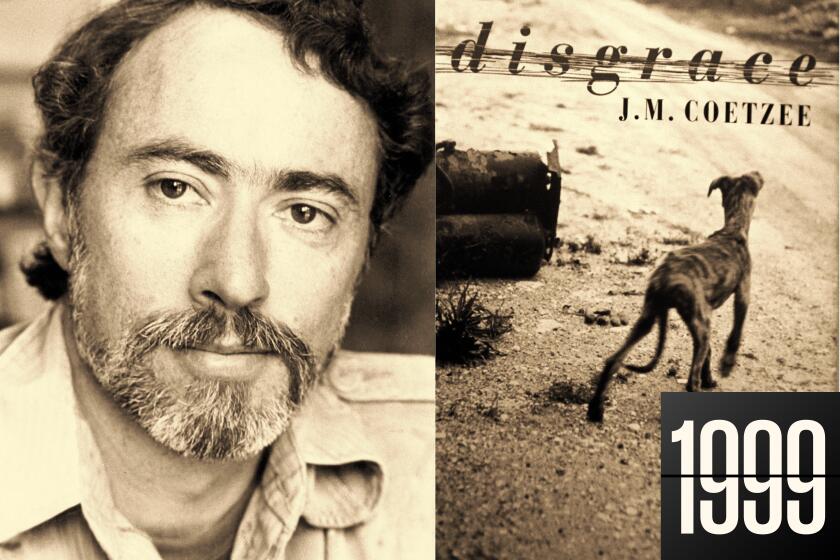BOOK REVIEW : Hope, Despair Clash in a Fictional Future in ‘Man After Man’
Charles Darwin’s theory of evolution has inspired science fiction writers from H. G. Wells to the present author, Dougal Dixon, to speculate on how humankind in the distant future will adapt, physically and mentally, to an ever-changing world.
These fictions tend toward either hope or despair. Wells’ “The Time Machine,” a Victorian-era “Blade Runner” dramatizing technological progress decaying into human viciousness, had already established the grimmer category by the turn of the century.
The stunningly illustrated, starkly written “Man After Man” falls squarely into the “Blade Runner” genre.
Dixon, a British university-trained paleontologist and geologist, has written extensively, for children as well as adults, on dinosaurs, geology and climate. His dark vision of the future reached many American readers in his 1984 book “After Man,” a beautifully illustrated bestiary of imaginary creatures the author proposes will populate the Earth in the absence of humans.
Now, in “Man After Man,” we learn that the humans in Dixon’s cosmos manage to hang on after all. With the help of natural selection aided by genetic engineering, artificial organs, luck and pluck, humans not only repopulate the Earth but move underwater and into space as well. But they manage to foul their nest all over again, in a future 5-million-year cycle that eerily recapitulates humankind’s first 5 million years.
As Dixon puts it, in a particularly epigrammatic passage, “Dig a shelter today. Build a house tomorrow. Clear a forest for a city the day after. Choke the landscape with the waste materials the next.”
In “Man After Man,” Dixon begins his prophecy with a highly compressed but readable recap of human evolution. He also teaches the reader the mechanisms of evolution, including an easy-to-grasp and clearly illustrated lesson on molecular genetics.
To keep the reader oriented through the prophesied future, Dixon provides a flowchart. There the reader can see when, in Dixon’s fictional future, humans help out natural evolution with genetic engineering and technological enhancement, producing a zoo of truly wondrous human creatures.
Most of the book is devoted to telling the story of the future of the human race. Instead of a conventional narrative, however, the story unfolds as a sequence of isolated, dramatic moments in the lives of individuals representing the 40-odd species of humans that evolve--or are engineered--to fill the various niches of the future.
These bizarre creatures range from hulking, furry, gape-mouthed tundra dwellers to a tiny, computerized bug in a black plastic pressurized suit, who sits astride a vaguely horselike species of human and communicates with it telepathically.
These future humans have two characteristics in common: they’re miserable, and they’re worried about where they’ll get lunch. Civilization and culture are nowhere to be found. All human relationships are strictly utilitarian. Family life, where it exists at all, seems based merely on the need for protection. Life is nasty, brutish and short, and death is unmourned. Dixon’s future world is not a pretty sight.
This bleak world is strikingly rendered--indeed, practically co-authored--by illustrator Philip Hood (who also contributed to Dixon’s “After Man”).
Among Hood’s most unforgettable drawings is the deep-space-adapted “vacuumorph.” Billed as “the ultimate triumph of the genetic engineer,” it resembles contemporary humans least of all. Spherical with a gray, pebble-grained hard shell (to prevent it from exploding in the perfect vacuum of space), it has prehensile feet for hanging onto safety rails on free fall, as well as spiny whiskers with which to communicate by touch in the silence of space.
Yet Hood’s drawings, including an anatomical cutaway, make the vacuumorph seem as familiar as a NASA astronaut. The strength of “Man After Man” is its ability to compel empathy with such strange creatures as the vacuumorph.
Scientists will doubtless quarrel with many details in “Man After Man.” For example, some of Hood’s renderings of musculature and skeleton are not quite right anatomically, and some of Dixon’s technological advances and genetic developments raise questions too involved to introduce here. But the scenarios Dixon describes are based on the author’s solid knowledge of nature’s workings, and the task of separating fact from fancy in this book is an amusing exercise.
In any case, despite the deep pessimism of Dixon’s vision, the immense scope and magisterial sweep of his fictional future of humankind will fascinate both adolescent and adult readers.
In fact, if enough young people read “Man After Man” and experience vicariously the inevitable consequences of greed, they may help the world escape the dark fate Dixon so powerfully evokes. Next: Jonathan Kirsch reviews “Stones in the Soul: A Day in the Life of an American Rabbi” by Ben Kamin (Macmillan). MAN AFTER MAN An Anthropology of the Future by Dougal Dixon illustrations by Philip Hood St. Martin’s Press
$19.95, 128 pages
More to Read
Sign up for our Book Club newsletter
Get the latest news, events and more from the Los Angeles Times Book Club, and help us get L.A. reading and talking.
You may occasionally receive promotional content from the Los Angeles Times.





